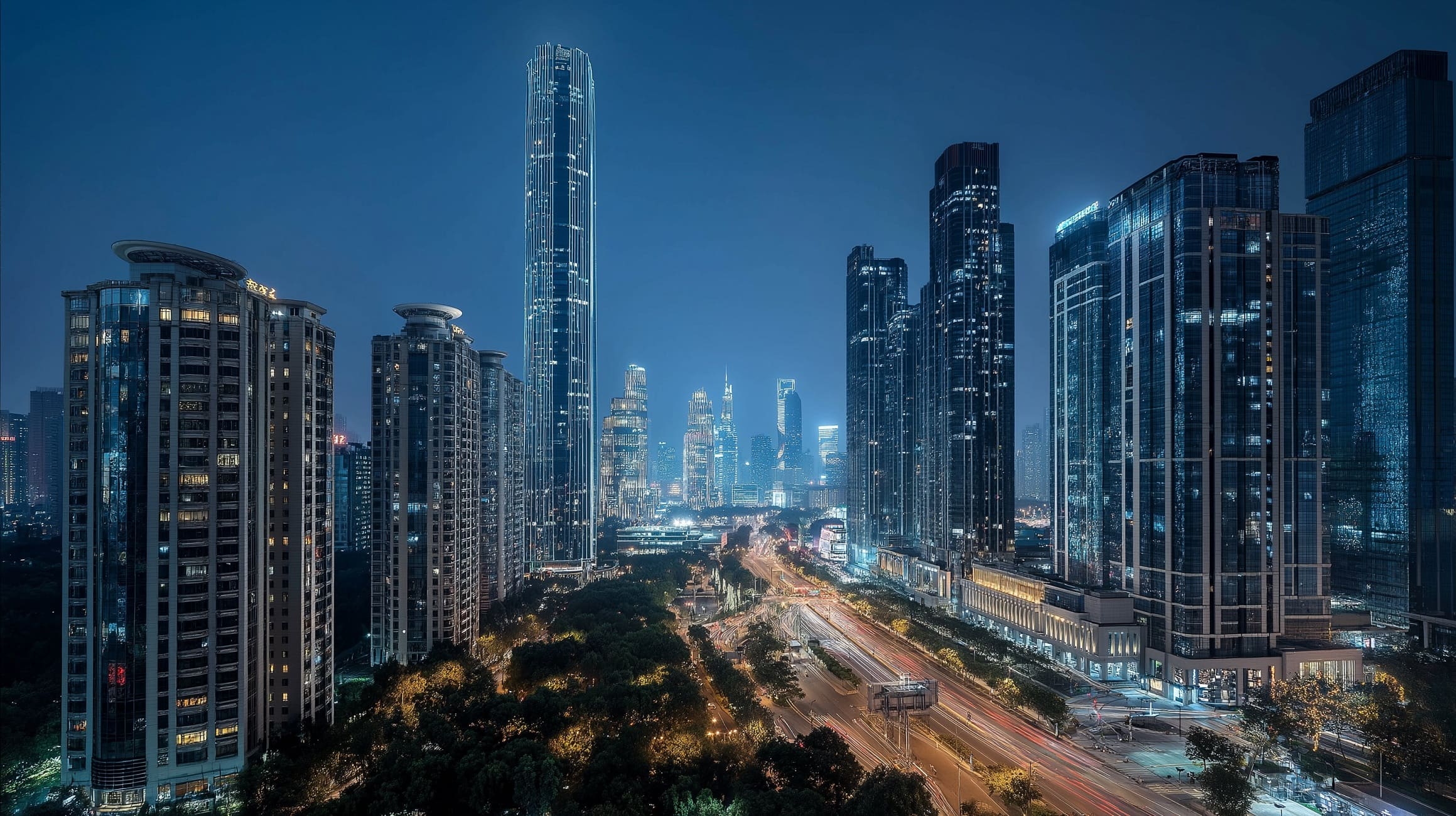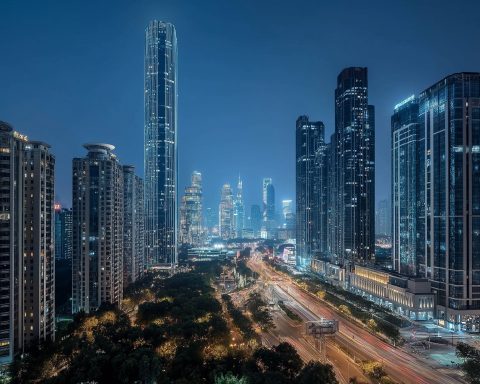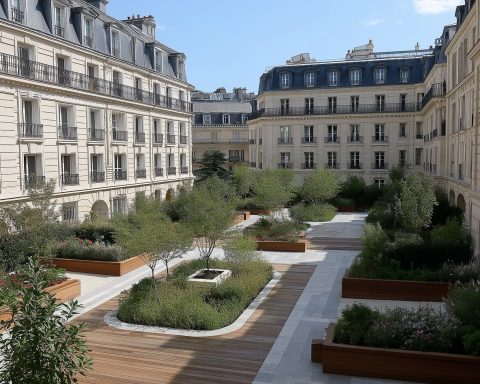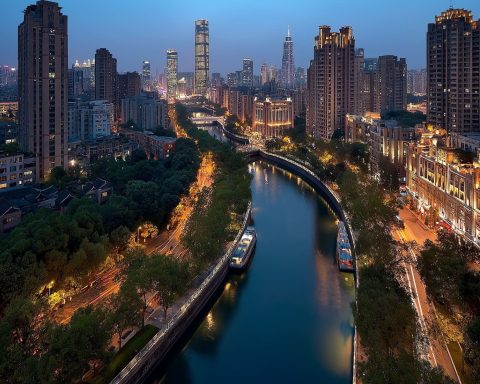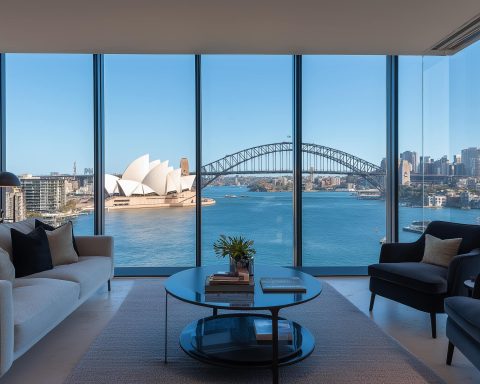Market Overview in 2025 (Residential & Commercial)
Guangzhou’s real estate market in 2025 reflects a mixed recovery amid earlier downturn pressures. In the residential sector, housing prices had been sliding through 2024 but showed signs of stabilizing by early 2025. New home prices in Guangzhou were about RMB 24,700 per square meter as of March 2025 – roughly flat (+0.15% YoY) – while second-hand home prices averaged around RMB 36,400 (still ~5.8% lower YoY). Transaction volumes rebounded notably: total new home sales area in Q4 2024 surged to ~2.12 million m², far exceeding new supply (1.05 million m²) as pent-up demand returned after policy easing savills.com pdf.savills.asia. By January 2025, first-tier cities (including Guangzhou) saw new home sales jump 16% year-on-year (after adjusting for Lunar New Year effects), indicating renewed buyer confidence in Guangzhou’s housing market.
On the commercial real estate side, 2025 has brought a wave of new supply and cautious recovery. In Grade A offices, Guangzhou saw significant new completions in emerging areas like the International Financial City submarket (adding ~255,000 m² in Q1 2025) cushmanwakefield.com. However, demand has not fully caught up, pushing the office vacancy rate to about 19.3% citywide and forcing landlords to trim rents cushmanwakefield.com. As of Q1 2025, average Grade A office rents fell ~4.8% quarter-on-quarter to roughly RMB 125 per m² per month cushmanwakefield.com, reflecting tenant-friendly conditions. The retail property segment is more stable: prime retail stock held at 5.8 million m², with policy-driven consumer spending (e.g. trade-in incentives for electronics) supporting tenant expansion. Retail vacancy edged up slightly to 8.7%, and average shop rents softened ~1.1% in early 2025. Overall, Guangzhou’s commercial market in 2025 is characterized by high supply and vacancy in offices but improving retail activity, while the residential market is gradually bottoming out after a challenging 2024.
Key Market Trends in 2025
- Price Trends: Guangzhou’s home prices underwent a correction in 2024 followed by stabilization in 2025. New residential prices dropped ~7% year-on-year by late 2024, but government stimulus helped arrest the decline. By March 2025, new home prices were down only 2.8% YoY on average across China’s top cities (and essentially flat in Guangzhou). Figure 1 below shows Guangzhou’s new house price index, which plunged in 2024 but began ticking upward in early 2025 as buyer sentiment improved. Second-hand house prices are recovering more slowly, still about 4–9% lower than a year ago in major cities. In Guangzhou, existing home values remain soft (-5.8% YoY in March) even as new home prices have firmed. In the commercial realm, office rents are under downward pressure from oversupply, while retail rents are relatively resilient with only mild declines cushmanwakefield.com.
- Supply and Demand Dynamics: Developer caution and policy changes have constrained new supply while boosting sales. Guangzhou’s new residential supply in Q4 2024 fell ~26% QoQ to ~1.05 million m², yet quarterly sales shot up by 45% (to 2.12 million m²) as buyers returned to the market savills.com pdf.savills.asia. This burst of demand helped reduce inventory levels. Land market activity, however, remained subdued – the total transacted area of residential land in Guangzhou plunged by about 50% in 2024, reflecting developers’ weaker appetite for new projects amid financing challenges. On the demand side, home purchasing in early 2025 was fueled by looser restrictions and lower mortgage rates. In January 2025, Guangzhou’s new home sales volume jumped despite winter holidays, though February saw a brief dip (sales -26% YoY for Guangzhou) before momentum picked up again. Occupier demand in commercial sectors is uneven: office leasing is driven by emerging industries (tech, finance, etc.) but not enough to fully absorb new supply cushmanwakefield.com, whereas retail leasing has benefited from consumer sectors like electronics and education expanding with government incentives.
- Vacancy Rates: High vacancy is a notable concern, especially in certain districts and property types. Guangzhou’s overall housing vacancy rate is estimated around 15–20% in urban areas, with higher emptiness on the city fringes. For instance, suburban Panyu District has the highest residential vacancy (~23% on average), compared to under 17% in core districts like Tianhe, Haizhu, and Yuexiu. This indicates significant unsold or empty housing stock in less-central areas. In the office market, as noted, the Grade A vacancy climbed to ~19% in early 2025 cushmanwakefield.com due to the influx of new buildings. Retail vacancies are lower (single digits) but have inched up as well (currently ~8.7% citywide). High vacancy puts pressure on prices and rents, and it signals that supply has outpaced short-term demand in segments of Guangzhou’s market. Landlords are responding with more flexible leasing terms and promotions to backfill empty units, a trend likely to continue until the excess supply is absorbed.
Profiles of Key Districts (Tianhe, Haizhu, Yuexiu, Panyu)
Guangzhou is a metropolis of diverse districts, each with distinct real estate characteristics. Below is an analysis of four important urban districts and their development and investment appeal:
Tianhe District
Tianhe is Guangzhou’s financial and commercial hub, hosting the Tianhe CBD and Zhujiang New Town – the city’s most modern skyline. It consistently ranks as the most expensive district for real estate, with average housing prices well above the city’s mean. As early as 2017, Tianhe’s average new home prices exceeded RMB 30,000/m² (about twice the citywide average at that time), and units in prime areas (e.g. Zhujiang New Town CBD) have reached as high as RMB 70,000/m² scirp.org. Today in 2025, Tianhe’s residential values remain top-tier in Guangzhou (roughly on par with Yuexiu), reflecting its central location and premium amenities. The district features luxury malls, Grade A offices, and high-end apartments that attract affluent buyers and corporate tenants. Infrastructure advantages – like extensive Metro connections and the new Line 11 loop serving Tianhe macaudailytimes.com.mo – further boost its appeal. From an investment perspective, Tianhe offers stability and prestige: properties here hold value due to scarce land and strong demand from professionals and expatriates. However, yields are relatively low (given high prices and moderate rents) and entry costs are steep. Still, Tianhe’s continued development (e.g. the emerging International Financial City area to the east cushmanwakefield.com) and concentration of Fortune 500 companies make it a core focus for long-term investors despite its high price tag.
Haizhu District
Haizhu lies just south of the Pearl River and is evolving from an older industrial/residential area into a new technology and exhibition zone. It encompasses the Pazhou sub-district – now Guangzhou’s Artificial Intelligence and Digital Economy Pilot Zone, where many tech firms and e-commerce companies have set up offices. This transformation is turning Haizhu into a tech hub, driving demand for both offices and upscale housing nearby. The district also hosts the Canton Fair complex and several universities, contributing to a vibrant rental market. Real estate in Haizhu is generally a notch below Tianhe in pricing, but has seen significant appreciation with the influx of tech industry investment. For example, new condos in desirable parts of Haizhu (near Pazhou or along the riverfront) command high prices, though overall averages are slightly more affordable than core Tianhe/Yuexiu. Haizhu’s attractiveness lies in its mix of convenience and new growth potential – it’s close to the city center, well-served by transport, and has large-scale redevelopment projects. Investors see opportunity in Haizhu’s ongoing urban renewal, as old factories and villages are redeveloped into modern complexes. A risk, however, is the supply pipeline: if too many new projects launch simultaneously in Pazhou, the area could face elevated vacancy or rent dilution. Still, medium-term prospects are positive as infrastructure (e.g. new metro lines and bridges) strengthens Haizhu’s connectivity and as government policies encourage the tech ecosystem there.
Yuexiu District
Yuexiu is Guangzhou’s historic downtown and administrative heart. It features government offices, heritage architecture, and established commercial streets. Residential stock in Yuexiu tends to be older (many traditional apartments), and new development land is limited. Nonetheless, Yuexiu remains one of the most sought-after addresses due to its centrality, mature amenities, and top schools. Average housing prices in Yuexiu rival Tianhe’s – above RMB 30,000/m² as of a few years ago and rising since scirp.org. The district’s attractive older neighborhoods and parks (like Yuexiu Park, Dongshan) draw families and white-collar workers, keeping demand robust. Investment potential in Yuexiu comes from selective urban renewal projects: the local government has initiatives to refurbish old residential communities and upgrade infrastructure in aging areas. Because large vacant land is scarce, most new supply comes from redevelopments, which are usually high-end and quickly absorbed by the market. Yuexiu’s rental market is stable, supported by a sizable population of civil servants and long-term residents; however, rent growth is modest given the older building stock. For investors, Yuexiu offers low volatility and solid long-term value retention. Property here is less speculative and more “blue-chip” in nature. A possible downside is slower modern growth – with limited new commercial projects, Yuexiu can feel static compared to fast-growing districts. Yet as the cultural and civic core of Guangzhou, Yuexiu’s prestige and scarcity of land ensure it remains an important part of the real estate landscape.
Panyu District
Panyu is a sprawling district to the south of the city, known for its residential expansions and family-friendly environment. Formerly suburban, Panyu has rapidly urbanized and is now well-integrated via highways and metro (hosting Guangzhou South Railway Station, the city’s high-speed rail hub). Housing in Panyu is considerably more affordable than in central Guangzhou – prices can be half or even less of those in Tianhe/Yuexiu, depending on location. Many large-scale housing estates, including newer high-rise communities with ample amenities, have been developed in Panyu to cater to middle-class and first-time buyers. Because of abundant land, supply in Panyu has been high, which contributes to the district’s higher housing vacancy rate (~23%) – the highest in Guangzhou. This oversupply risk means price appreciation in Panyu has been more subdued. However, Panyu’s attractiveness lies in its balance of reasonable cost and improving infrastructure. The district boasts attractions like Chimelong (a major theme park), university town campuses, and new industrial parks. The upcoming metro and intercity rail projects will further cut travel times between Panyu and the city center macaudailytimes.com.mo macaudailytimes.com.mo. For investors, Panyu presents opportunities in rental yields slightly higher than core districts (due to lower entry prices) and in long-term capital growth as Guangzhou’s urban footprint expands. The risks are longer holding periods for gains to materialize and potential liquidity issues (properties may take longer to sell in a soft market). Overall, Panyu is positioned as Guangzhou’s “next frontier” for urban growth – a district where the city’s future population influx can be accommodated at a more accessible price point.
Government Housing and Land Policies
Government policy has been a decisive factor in Guangzhou’s real estate trajectory. In late 2024 and into 2025, authorities rolled out measures to stabilize the housing market and spur buying. A key move was the easing of home purchase restrictions (HPRs). Guangzhou’s municipal government, in fact, completely relaxed purchase limits – by January 2024 it allowed almost unrestricted home buying in the city. For example, effective 27 January 2024, any residential unit larger than 120 m² was allowed to be transacted freely without the prior limitation on eligibility pdf.savills.asia. This essentially lifted restrictions on owning multiple large apartments and was aimed at stimulating upgrader demand. Such local relaxation was in line with nationwide signals that “housing is for living, not for speculation” but that reasonable end-user demand should be supported.
Other supportive policies include lowering mortgage costs and taxes. The People’s Bank of China cut interest rates (the 5-year loan prime rate is down to 4.3%) and guided banks to reduce rates on existing mortgages, giving many Guangzhou homeowners a ~0.5 percentage point interest reduction in 2024. Down payment requirements were unified and reduced – now 15% minimum for first and second homes nationally – making it easier for buyers to upgrade homes. The government also slashed transaction taxes for people selling their current home to buy a new one (to encourage housing upgrades). These policies combined have unlocked housing demand by reducing buyers’ financial burden.
On the land supply side, Guangzhou followed China’s centralized land auction system, but the city scaled back land sales amid the market cooldown. As noted, the area of residential land sold in 2024 dropped by about 50% YoY – a deliberate move to prevent oversupply and to stabilize land prices. The city also promoted redevelopment of idle or under-used urban land (like old villages) instead of fresh greenfield expansion, aligning with the urban renewal initiatives in the national policy package. Additionally, Guangzhou was included in the central government’s “white list” of safer developers, meaning select financially-sound developers could receive support and financing to ensure project delivery. This helps address buyer confidence in pre-sold housing, ensuring projects in Guangzhou don’t stall due to developer liquidity issues.
In summary, Guangzhou’s policy environment in 2025 is one of targeted relaxation and support: loosening purchase limits, cutting financing costs, and carefully managing land supply. These measures have begun to revive market activity (especially new home sales), though authorities remain vigilant about speculative excess. The balance of encouraging real demand while curbing speculation is delicate – but so far, policy support has been pivotal in turning Guangzhou’s property market toward recovery in 2025.
Infrastructure Developments Impacting Real Estate
Massive infrastructure investments in Guangzhou are reshaping the city and influencing real estate values. In 2025, Guangzhou’s transport network is undergoing a major expansion. The city plans to open 10 new metro and intercity rail lines within the year, adding 173 kilometers of track macaudailytimes.com.mo. This rapid build-out includes brand new Metro lines and extensions that improve access to peripheral districts. For instance, Metro Line 11, a 44-km inner loop line, was inaugurated in late 2024, linking key districts Tianhe, Yuexiu, Liwan, Haizhu and Baiyun in a circle macaudailytimes.com.mo. Such enhancements in connectivity make previously far-flung neighborhoods more attractive for both residential and commercial development. Properties near new stations (for example, along Line 11’s route or the upcoming Line 10 in dense areas barchart.comeguangzhou.gov.cn) are expected to see value appreciation and higher demand due to reduced commute times.
Guangzhou is also strengthening its integration within the Greater Bay Area (GBA) through improved intercity transport. A new northern extension of the Guangzhou-Qingyuan intercity railway recently opened macaudailytimes.com.mo, and the high-speed rail link from Guangzhou to Hong Kong has seen a surge in usage – over 27 million trips between Guangdong and Hong Kong were made via high-speed rail in 2024, up 37% from the prior year macaudailytimes.com.mo. This greater mobility facilitates business travel and commuting across the region, boosting Guangzhou’s appeal as a regional hub. It can potentially draw cross-border investment and housing demand (e.g. Hong Kong buyers looking for property in Guangzhou given easier access).
Beyond transport, industrial and technology parks are key infrastructure shaping the real estate market. Guangzhou’s development of the Pazhou Artificial Intelligence and Digital Economy Zone in Haizhu is a prime example. This 81 km² zone (with Pazhou as the core) is attracting tech companies and start-ups, supported by government initiatives cnbayarea.org.cn newsgd.com. As Pazhou fills with new office campuses and innovation labs, there is concurrent demand for nearby apartments, restaurants, and hotels. Similarly, in Huangpu district (just outside our four focus districts), projects like Sino-Singapore Guangzhou Knowledge City and Guangzhou Science City are drawing professionals, which increases housing needs in eastern Guangzhou and adjacent areas.
Urban renewal projects are another facet of infrastructure development. Guangzhou’s authorities have been renovating aging neighborhoods and former factory sites to create new usable space. For example, old urban villages in prime locations are being redeveloped into modern mixed-use communities. These urban renewal efforts not only improve living conditions but also effectively add supply in central areas without expanding the city’s footprint. One notable project is the ongoing upgrade of the Tongde Wei area in Yuexiu and parts of Haizhu, converting dilapidated housing into mid-range apartments – this increases housing stock where it’s most needed. Additionally, Guangzhou is investing in public amenities (parks, waterfront promenades along the Pearl River, cultural facilities) which enhance neighborhood desirability and thus real estate values.
In essence, Guangzhou’s infrastructure boom – from transit lines to tech parks to renewal of old districts – is a major tailwind for its property market. Improved transportation is knitting the metropolitan area closer, reducing the centrality premium and spreading demand more evenly. New commercial hubs (financial districts, innovation zones) are creating employment centers outside the traditional downtown, which in turn stimulates housing markets in those locales. These developments are expected to continue through 2030, underpinning real estate growth, though areas lagging in connectivity may see less benefit. For investors and homebuyers alike, proximity to new infrastructure is increasingly a key factor in Guangzhou, as it often correlates with capital appreciation potential.
Investment Opportunities and Risks
Investment Opportunities: Guangzhou offers a range of opportunities for both domestic and international real estate investors, owing to its status as a Tier-1 city and a driving force in the Greater Bay Area. One opportunity is capitalizing on the market dip: after the price corrections of 2024, entry prices in 2025 are relatively attractive in historical context, especially in suburban districts. Investors with a medium-term view could benefit from the expected recovery and moderate price uplift in coming years. Guangzhou’s strong economic fundamentals (diverse industries, manufacturing base, growing tech sector) and continued population growth ensure steady end-user demand for housing. Rental properties can also be appealing – the city’s push for affordable long-term rental housing and the rise of institutional landlords indicate a maturing rental market. While gross rental yields are not high (averaging ~2–3% in prime areas), they are somewhat better in cheaper districts like Panyu or outskirts, and rental demand is solid due to the large student and migrant workforce population.
Another opportunity lies in commercial real estate segments poised for growth. For instance, Guangzhou’s logistics and industrial property sector is seeing upgrading and expansion – modern warehouses and business parks in locations like Nansha and near the ports are in demand as e-commerce and trading flourish. Investors can find value in these non-residential assets with higher yield profiles. The office market, although soft now, presents opportunities in emerging submarkets: properties in the new International Financial City or Pazhou area might be acquired at a discount while the area is still developing, with potential upside as those districts mature and backfill with tenants. International investors may also look at Guangzhou’s hospitality and retail assets, anticipating a rebound in tourism and consumer spending as China’s economy normalizes post-pandemic (Guangzhou historically hosts many trade fairs and conventions that drive hotel demand).
Policy support also creates investment openings. The government’s favorable stance on rental housing (including land allocation for rental projects and tax incentives) could make build-to-rent developments financially attractive. Likewise, urban renewal projects often welcome private investment partnerships – developers who specialize in urban redevelopment might find Guangzhou’s initiatives a fertile ground, with city authorities keen on joint ventures to revitalize older areas. Finally, as a GBA city, Guangzhou stands to gain from regional integration; investors might target properties near transportation hubs (like Guangzhou South Station or new intercity rail stops) that could become future commercial hotspots.
Investment Risks: Despite its opportunities, Guangzhou’s real estate market carries several risks that investors must heed. One primary risk is the lingering oversupply in certain segments. The high residential vacancy rates in areas like Panyu signal that some properties could struggle for occupancy or capital appreciation in the short term. If demand recovery is slower than expected, investors holding multiple units may face prolonged selling timelines or need to offer deep discounts. The office sector’s oversupply is another risk – with a near 20% vacancy and more projects in the pipeline cushmanwakefield.com, office rents could stay depressed for years, making it hard to achieve attractive returns on office investments.
Another risk factor is policy uncertainty and regulatory control. While current policies are supportive, the Chinese government can change housing regulations quickly in response to market conditions. For example, if prices were to rebound too fast, authorities might re-impose buying curbs or stricter credit controls, which would dampen investor activity. International investors also face foreign exchange and repatriation risk – China maintains capital controls, so moving large sums of rental income or sale proceeds out of the country can be challenging. Moreover, currency fluctuations (RMB value) can affect the real return for foreign investors.
Economic and developer health risks are present as well. China’s broader property downturn has put several developers in distress. Although Guangzhou’s market is relatively healthier, a few developers operating locally (including some tied to Evergrande or others) have faced liquidity problems, potentially delaying project completions. The government’s “white list” support mitigates this, but investors buying pre-sale units or partnering in development projects must conduct due diligence on developer finances. Macroeconomic factors, such as interest rate trends and trade-related economic slowdowns, also pose risks; higher unemployment or slower income growth in the region could temper housing demand in the coming years.
Finally, investors should consider the low yield, high valuation environment of Tier-1 cities. In places like Guangzhou, much of the return on residential property historically comes from capital appreciation, not rental yield. If the era of double-digit price growth is over (as many analysts predict modest 1-3% annual gains after 2025), then the investment calculus changes. Long-term holders might still see solid returns, but short-term flippers will find it harder to profit. In summary, Guangzhou offers a rewarding but complex investment landscape: prudent investors will diversify (across districts and asset types), leverage the current policy tailwinds, and maintain a sufficient horizon to weather cyclical lulls.
Market Outlook and Forecasts (2026–2030)
Looking ahead, the consensus among experts is that Guangzhou’s real estate market will enter a period of gradual recovery and moderate growth. After the correction phase, 2025 is seen as a turning point: a Reuters poll of analysts forecasts Chinese home prices to fall about 2–2.5% in 2025, then stabilize and return to mild growth by 2026 reuters.com. In line with this, Guangzhou’s housing prices are expected to bottom out and then rise at a modest pace through the latter 2020s. One projection suggests nationwide prices could tick up ~1–2% in 2026–2027. For Guangzhou specifically (as a first-tier city with strong fundamentals), price growth may outperform the national average slightly – perhaps in the low single digits annually – assuming the broader economy remains healthy. There is upside potential from the Greater Bay Area integration, which could bring additional housing demand and investment into Guangzhou through 2030.
On the commercial side, office market recovery may be slow. Some analysts even speak of a “lost decade” for Chinese offices due to structural supply glut and new work trends. Guangzhou’s office vacancy might remain elevated into the late 2020s until excess stock is absorbed. However, continued economic expansion in high-value sectors (finance, tech, advanced manufacturing) should gradually improve office absorption. By 2030, Guangzhou’s Grade A office rents could regain growth momentum once the market rebalances, though the days of rapid rent hikes seen in the 2010s are likely over. Retail real estate has a more positive outlook, buoyed by Guangzhou’s population growth and rising consumer spending. International retailers and F&B brands continue to see Guangzhou as a key market, so prime retail rents and occupancy are forecast to stay strong, with new experiential retail projects (malls integrated with entertainment and culture) coming on stream by 2030.
In terms of quantitative forecasts, research firms provide some big-picture estimates: The China real estate market (overall) is projected to grow at a ~3.9% compound annual rate from 2025 to 2030, reaching around USD 7 trillion in value by 2030. For the residential segment, one estimate puts China’s total residential transaction value at RMB 20 trillion by 2030, of which Guangzhou would comprise a significant share as one of the top markets. Real estate consultancy JLL and CBRE have indicated cautious optimism – they expect Guangzhou’s property sales and prices to stabilize in 2025 and then pick up slightly, supported by the city’s solid economic base and infrastructure improvements (like the completion of multiple metro lines by 2027). By 2030, Guangzhou is also anticipated to benefit from population inflows due to urbanization and its attractiveness to talent within the GBA. The city’s 14th Five-Year Plan (2021–2025) and beyond includes goals to add millions of square meters of housing and to keep housing affordability in check, suggesting that while supply will grow, it will be matched to demographic needs.
It’s important to note that uncertainties remain in the long-term outlook. These include global economic conditions, China’s policy direction (e.g. a potential property tax by 2030 could alter investment behavior), and technological shifts like remote work (which could affect office demand). Nevertheless, Guangzhou’s position as a trade and industrial powerhouse and a regional transportation node gives it resilience. The general expectation is for moderate, sustainable growth rather than a return to boom times. As one analyst summarized: “We foresee new home prices stabilising in 2025 and ticking up thereafter”. Most forecasts to 2030 see Guangzhou’s real estate aligning with stable economic growth – incremental price increases, high but improving volumes, and a maturing market with more emphasis on quality and sustainability.
Table 1: Housing Prices in China’s Tier-1 Cities (March 2025)
| City | Avg New Home Price (RMB/m²) | YoY Change (New) | Avg Second-Hand Price (RMB/m²) | YoY Change (Second-Hand) |
|---|---|---|---|---|
| Beijing | 46,079 (US$6,420) | +1.8% | 68,714 (US$9,580) | –6.5% |
| Shanghai | 57,588 (US$8,030) | +10.1% | 59,500 (US$8,290) | –6.3% |
| Guangzhou | 24,744 (US$3,450) | +0.15% | 36,385 (US$5,070) | –5.8% |
| Shenzhen | 52,705 (US$7,350) | –0.4% | 67,587 (US$9,420) | –3.3% |
Source: CREIS via Global Property Guide. Guangzhou’s housing is less expensive than Beijing, Shanghai, or Shenzhen on average, indicating relative affordability among Tier-1 cities.
Overall, Guangzhou’s real estate market by 2030 is envisioned to be larger, more balanced, and more institutionalized. Home price growth will likely be modest but positive, supported by end-user demand rather than speculation. Rental housing will play a bigger role in the market. The city will continue investing in connectivity and livability, further integrating its districts and surrounding cities. For investors and stakeholders, the next 5–10 years in Guangzhou promise steady gains with fewer extremes – a maturation process that marks Guangzhou’s transition into a truly modern global city real estate market.
Sources: Official government releases, market research reports, and news analyses were used to compile this report, including data from Savills, Cushman & Wakefield, Global Property Guide, Reuters, and Guangzhou city statistics cushmanwakefield.com pdf.savills.asia. These provide a current view (as of mid-2025) and informed projections for the Guangzhou real estate market through 2030. All monetary figures are in Chinese Yuan (RMB) unless otherwise noted.
